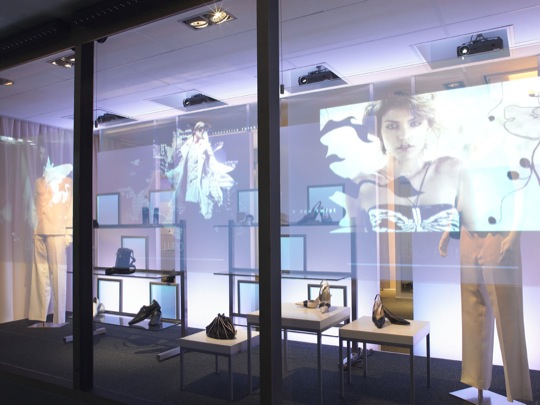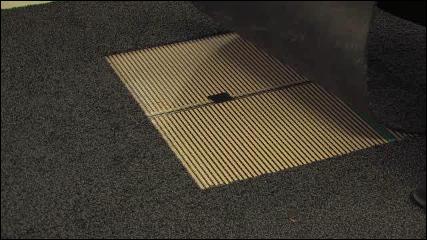
The ShopLab at the Philips research center is a prototype retail store room used to test lighting technology to improve the sales experience for both the establishment and the customer. First up is the Show Window, a series of projectors displaying on the exterior showcase
windows. These projectors show a rotating collection of images on the glass, behind which sits the showcase products. As passers-by stop at the window, the projectors switch to displaying an invitation to the user to simply look at the product about which they would like to know more. Infrared cameras track the person’s gaze, and as they look at the various products the projectors display additional information or recommended accessories.
The projectors can also display a completely interactive user interface onto the window, relying on motion sensing cameras to detect which navigation control the person might point to. Entire interactive catalogs can be put on the show window, allowing folks to get product information simply by walking up to the window.






The wall works exactly as advertised when in the lab, though a few challenges remain before it’s ready for the real world (i.e. who’s eyes to follow when multiple people are pressed up to the window
simultaneously?).
Once inside the ShopLab, specific products can be highlighted with color cubes. These simple boxes have a bright white light and a camera discretely mounted in the top, and an LED panel in the rear.
As objects are placed in the cube they are bathed in cool white light. The camera detects the dominant color in the object and the LED wall changes colors to compliment that color. This creates a visually appealing display that can be changed simply by placing a different product in the cube. Although it was in the ShopLab, the same thing could be used for a fancy shadowbox in someone’s home.
Specific lighting for specific products is neat, but it’s nothing compared to completely re-lighting an entire section of a store on the fly. The showcase feature of the ShopLab does just that. A simple
flipbooks sits atop a counter, filled with colorful photos. As the photo pages are flipped, an RFID chip embedded in each page is identified and used to adjust the room lighting to match the colors of
the picture. Currently the lighting effects are entirely programmed to represent the photos, but there is work underway to allow arbitrary photos to be processed to automatically create a
lighting solution that matches. Walls are bathed in the dominant colors, along with LED-embedded ceiling tiles, and specific areas can be given highlight colors. Testing in the ShopLab has already taught the engineers that the transitions need to be smooth, first dimming the current lighting then slowly brightening the desired lighting.
The suggested use for this system is to allow retailers to more quickly adjust their interiors to the color schemes of the season or the products; and to create more inviting environments that encourage shoppers to feel good about the products on display. It can also be used to show how specific products look in certain environments.
